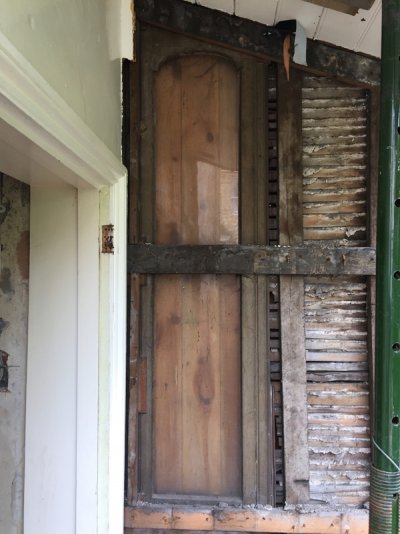Hello PPUK,
Sadly, we're having to undertake a full demolition and rebuild of a timber framed single storey extension. It's striking that it has stood as long as it has, let alone not collapsed when a roofer was clambering on top fixing the slate roof.
The extended cold spell that we had a couple of months ago was a blessing in at least one instance. It caused the freezing and blowing of a small section of the external render off of the laths. This revealed that the timber plate was completely rotten (the ground levels had been above it for quite likely decades) and further examination showed that the rest of the timber frame was in extremely poor condition. Further excavation showed that the brick "footings" were only a couple of courses of bricks so dropping the outside ground levels to below the inside floor level was going to be problematic. Since this single course of bricks was barely holding together anyway we decided to start again.
A trench has now been dug and reinforced concrete footings have been poured. The plan is to now build brickwork up to the level where the older brickwork was. My question is what to use as the mortar. In one section about 4 or 5 courses of bricks will be visible above the new ground levels and in another section about 12 courses will be visible. Our bricklayer will likely suggest a sand and cement mortar. Is this recommended or would a slaked lime and sand mortar be more appropriate? Is there a reason not to use lime mortar in brickwork that will be underground?
Many thanks.
Scott
Sadly, we're having to undertake a full demolition and rebuild of a timber framed single storey extension. It's striking that it has stood as long as it has, let alone not collapsed when a roofer was clambering on top fixing the slate roof.
The extended cold spell that we had a couple of months ago was a blessing in at least one instance. It caused the freezing and blowing of a small section of the external render off of the laths. This revealed that the timber plate was completely rotten (the ground levels had been above it for quite likely decades) and further examination showed that the rest of the timber frame was in extremely poor condition. Further excavation showed that the brick "footings" were only a couple of courses of bricks so dropping the outside ground levels to below the inside floor level was going to be problematic. Since this single course of bricks was barely holding together anyway we decided to start again.
A trench has now been dug and reinforced concrete footings have been poured. The plan is to now build brickwork up to the level where the older brickwork was. My question is what to use as the mortar. In one section about 4 or 5 courses of bricks will be visible above the new ground levels and in another section about 12 courses will be visible. Our bricklayer will likely suggest a sand and cement mortar. Is this recommended or would a slaked lime and sand mortar be more appropriate? Is there a reason not to use lime mortar in brickwork that will be underground?
Many thanks.
Scott

